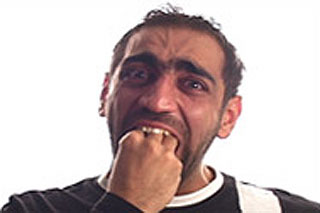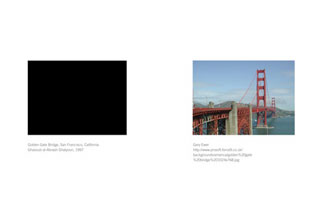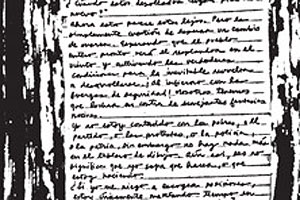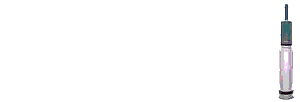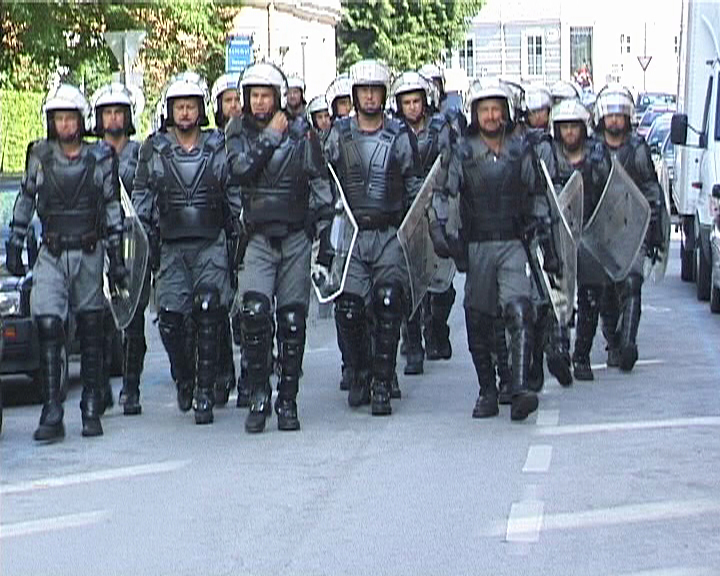 Oliver Ressler
Oliver Ressler, born in Knittelfeld, Austria, in 1970, lives and works in Vienna.
Oliver Ressler is an artist who is doing projects on various socio-political themes. Since 1994 he has been concerned with theme specific exhibitions, projects in public space, and videos on issues of racism, migration, genetic engineering, economics, forms of resistance and social alternatives. Many of Resslers works are realized as collaborations: The ongoing project
“Boom!” with the US-artist
David Thorne, the videos
“Venezuela from Below” and
“Disobbedienti” with the political analyst
Dario Azzellini, and numerous of projects on racism and migration with artist
Martin Krenn.
Projects 235.000.000.000 / 777.000.000.000.000
235.000.000.000 / 777.000.000.000.000Intervention by Oliver Ressler at the main train station in Zurich, eBoard, 2006
During the exhibition at the Shedhalle a new piece made for the electronic billboard of the Zurich main train station will be shown. The piece displays the foreign debts of Africa in relation to the damages which were caused by colonialism and slavery on this continent. If it is possible to elicit the foreign debts of Africa, which were tripled between 1980 and 2000, out of the World Banks databanks (235 billion dollars for the ‘Sub-Saharan Africa’ 2004), then the calculations of the damages caused by colonialism and slavery represent a disparate and much more difficult undertaking. At the occasion of the UN World Conference against Racism in Durban in 2001 the African World Reparations and Repatriations Truth Commission brought forward a calculation based on comprehensive research and announced the sum of 777 trillion dollars. The claims of the African states were calculated using the reparation numbers of Germany for the victims of the Nazi-Regime as a point of reference. Out of fear of amend claims the Western countries deny any responsibility for colonialism and its aftermath and decline a guilt confession.
 The Fittest Survive
The Fittest SurviveFactors like “danger”, “risk” and “wilderness” are no longer considered only in the dark, suppressed underside of the globalisation dream. These possibly deterring factors have become a resistance to be overcome by, apparently, only the best and the strongest. Thus, to a certain extent, mastering these daunting elements have become standards for achievement in the economic discipline. The crisis regions’ growth markets make particularly clear that the law of market economics requires hardness and ruthlessness. This warlike character of market economics transforms life into a fight in which specific individuals face ever-higher demands for better performance.
In order to prepare for this competitive, social Darwinist, pecking order of global capitalism, privately-owned, security enterprises offer their self-developed, civilian training programs that simulate conflict-situations – in varying complexities up to war scenarios. One of these enterprises, the British AKE Group, promises, according to their web page, to provide “...clients the competitive advantage of engaging safely in areas that might otherwise have been closed to opportunity.”
The video “The Fittest Survive” is based on filming the five-day course “Surviving Hostile Regions” done in January 2006 in Wales, Great Britain by the AKE Group. The course instructors are British ex-special force soldiers. The participants are businessmen who are preparing for business in Iraq and other dangerous regions, government officials and mainstream journalists who, with their dishonest discourse of democracy and human rights, help to legitimise and secure the ideology of market-economics expansion.
 5 Factories–Worker Control in VenezuelaDario Azzellini
5 Factories–Worker Control in VenezuelaDario Azzellini & Oliver Ressler, 81 min.
In their second film regarding political and social change in Venezuela, after
“Venezuela from Below” (67 min., 2004), Azzellini and Ressler focus on the industrial sector in “5 Factories–Worker Control in Venezuela“. The changes in Venezuela's productive sphere are demonstrated with five large companies in various regions: a textile company, aluminum works, a tomato factory, a cocoa factory, and a paper factory. In all, the workers are struggling for different forms of co- or self-management supported by credits from the government. “The assembly is basically governing the company”, says Rigoberto López from the textile factory “Textileros del Táchira” in front of steaming tubs. And coning machine operator Carmen Ortiz summarizes the experience as follows: “Working collectively is much better than working for another–working for another is like being a slave to that other”.
The protagonists portrayed at the five production locations present insights into ways of alternative organizing and models of workers' control. Mechanisms and difficulties of self-organization are explained as well as the production processes. The portrayal of machine processes could be seen as a metaphor for the dream machine of the “Bolivarian process”, and the hopes and desires it inspires among the workers. The situation in the five factories varies, but they share the common search for better models of production and life. This not only means concrete improvements for the workers. Aury Arocha, laboratory analyst at the ketchup factory “Tomates Guárico”, emphasizes that the difference between “social production companies” (EPS) and capitalist corporations is that the EPS “work for the community and society”. Carlos Lanz, president of the second largest aluminum factory in Venezuela, Alcasa, coins the key question: “How does a company push toward socialism within a capitalist framework?” The film ends with an extended sequence from a management meeting at Alcasa, a company with 2.700 workers, with discussions about co-management and the changes of production relations they aspire towards.
 Alternative Economics, Alternative Societies
Alternative Economics, Alternative SocietiesA series of billboards, posters and banners by Oliver Ressler
The central idea behind the billboard series “Alternative Economics, Alternative Societies” is to present different suggestions, which might be of interest when considering the principles on which an alternative to the existing capitalist system could be based. Such a society should in my opinion be less hierarchical, based on ideas of direct democracy and involve as many people as possible in decision-making processes. In the field of economy this would lead towards a variety of different models of workers self-management. The billboard series, which has been carried out in public inner-city spaces in Europe and South America so far, might provide some ideas for people who are interested in thinking about a future society. The billboards can work as food for thought, as the basis for discussions, which are so necessary today when strategies for alternatives are not clear. But it also has to be clear that a desirable society should be realized and created by the people who live in it. A model, which prescribes and determines every aspect of this future society, cannot lead towards an ideal society.
The poster and billboard texts, with their large and highly visible fonts, are in the form of appeals, questioning existing dominant power relationships and indicating alternatives that share the rejection of the capitalist system of rule. Some of the ideas presented in this project have been elaborated upon in concepts such as “Participatory Economy” by Michael Albert, “Inclusive Democracy” by Takis Fotopoulos, are suggestions for an anarchist consensual democracy by Ralf Burnicki, or are based on considerations by the theorist John Holloway, especially in his book “Change the World Without Taking Power”. This project uses the format of posters and billboards as arenas for the imagination. “Imagination is a very powerful liberating tool. If you cannot imagine something different you cannot work towards it”, explains Marge Piercy in a video interview conducted for the ongoing exhibition project “Alternative Economics, Alternative Societies” by Oliver Ressler, to which this project is related.
The first presentation of this poster series took place in the framework of the project “Quicksand in De Pijp” by SKOR and Combiwel, curated by Amiel Grumberg, which was a program of artistic interventions taking place in the De Pijp neighborhood of Amsterdam in 2004. Since then, the posters, billboards or banners have been displayed in several cities, invited and funded by art institutions, and always carried out in the local language. Sometimes the presentations in public inner-city spaces were linked with the ongoing exhibitions project
“Alternative Economics, Alternative Societies”, which was the case with the poster presentations in Rijeka, Karlsruhe and Lima. Sometimes the billboards were realized on their own (as in Bratislava and Copenhagen). While in Amsterdam around 2000 posters were placarded more or less illegal throughout several months, in Bratislava the large-scale billboards were displayed on city-owned commercial billboard sites, which were left for free to the Billboartgallery Europe, which makes them available for artists. In several of the other presentations, the house facades of art institutions, which invited me to realize works, were used for the public interventions.
 The global 500
The global 500The 500 largest companies, which are annually published in a ranking by the economic magazine Fortune, as transnational "global players" can be seen as the main protagonists of economic globalization. Starting point of the project "The global 500" is research done on the websites and the annual reports of the 500 largest transnational companies. The website, the exhibitions and the video in it are based on a selection of these corporate statements representing different strategies and discourses of economic globalization. These hegemonic globalization theses are discussed, analyzed and criticized by representatives of unions and NGOs, theorists and an economist.
 “In fortress Europe you still have holes where we can enter, and people are still entering.”
“In fortress Europe you still have holes where we can enter, and people are still entering.”
(Jean Jacques Effson Effa, The Voice)Border Crossing ServicesThe European Union member states' restrictive immigration regulations mean that there is almost no chance to legally migrate to the EU and reside in a member state. For those who want to enter, making use of border crossing services is often the only possibility for penetrating “Fortress Europe.”
The goal of the project “Border Crossing Services” (“Dienstleistung: Fluchthilfe”) is to redefine and highlight the positive aspects of terms such as “smuggler” or "trafficker" which have been given a negative connotation through the dominant medial discourse. In contrast to the widespread model for representation, the actual act of “smuggling” is not presented as a criminal exploitation of asylum seekers. Instead, we highlight the service character of this business made necessary by European policies of exclusion. Associated themes such as borders, migration and escape were worked on in cooperation with anti-racist groups, migrant organizations and students at the University of Lüneburg.
The project “Border Crossing Services” was realized in a variety of media such as a direct mailing and a video which, together with additional fields of information, form an exhibition in the Kunstraum Lüneburg. The project is based on a process-oriented approach. Throughout the course of the project, results from the different areas of research mutually influenced the other aspects of the project.
 European Corrections CorporationA Project by Martin Krenn & Oliver Ressler / Container Installation in Graz and Wels
European Corrections CorporationA Project by Martin Krenn & Oliver Ressler / Container Installation in Graz and WelsThe institution prison is an instrument of discipline, punishment, and exclusion, and functions as an agent of control and normalization. In today's society, the prison also has an additional important role as a site of economic production, in which the prisoners must work for a minimum wage. For the most part, it is the expanding prison industry that profits from this enterprise.
In the U.S., corporations such as Wackenhut and Corrections Corporation of America (CCA) have aspired to high profits through building and operating correctional facilities since the 1980s. Their influence has also continued to increase in Europe for the past years. They consider the European market as a growth market, which they want a share of as early as possible. CCA has pushed forward the construction and management of partially privatized prisons in France. Wackenhut and CCA have already been building and running correctional facilities in Great Britain for more than ten years. There, not one single state prison has been built since opening the prison system to private companies.
The project "European Corrections Corporation" focuses on the phenomenon of the advancing privatization of prisons in Europe and questions the institution prison. A walk-in container, 605 x 243 x 259 cm, covered with a printed tarpaulin, will be placed in the pedestrian zones in the center of Graz and Wels. On the tarpaulin is a detailed CAD graphic with text commentary, which visualizes a private corporation's future privatization and rebuilding of the Graz-Karlau and Wels correctional facility. Like a real company, EUCC (European Corrections Corporation) attempts to use the prison as a de-territorialized site of production within the capitalist economy and presents a model for the profitable utilization of the prisoners' labor power. Thus, the constructions of prison buildings in the correctional facilities in Graz and Wels is meant to double the number of spaces available for prisoners.
Projected inside the container will be a seventeen-minute video based on an interview with the British activist Mark Barnsley. Barnsley was incarcerated for eight years in twenty-two different private and state prisons in Great Britain and consistently refused to work there. Barnsley shows that underlying both state run and privately run prisons is the idea that criminality is a disease and a social evil, which they attempt to maintain with force, with disciplinary machines. The video thematizes the function and the transformation of the prison as an institution and shows possibilities for resistance inside and outside of the prisons.
 This is what democracy looks like!
This is what democracy looks like!The video "This is what democracy looks like!" thematizes the events of 1 July 2001 which took place surrounding a demonstration against the World Economic Forum - a private lobbying organization of major capital - which was meeting in Salzburg at the time.
"At those meetings, in the absence of the public, billion dollar deals are set into motion by the self-appointed 'global leaders.' These deals bring wealth and prosperity to a few, and exploitation and poverty to many. To assure the orderly proceedings of economic globalization, the conference facilities, located in the center of Salzburg, are largely blocked off and all demonstrations are forbidden other than a rally at the square in front of the train station." (Excerpt from the introduction of the video)
This video gives insight into the course of events of the first "anti-globalization demonstration" in Austria, held subsequent to the demonstrations in Seattle, Prague, Davos, Quebec, and Gothenburg, which all received a great deal of media attention. In this demonstration in Salzburg, which was forbidden by the police, 919 demonstrators were encircled in a police blockade and detained for over seven hours
In the video "This is what democracy looks like!" anti-capitalist demonstrators take the role of active spokespersons, contrary to dominant media representations that denigrate them as either naive or violent chaotic rowdies. Conversations about the events in Salzburg were carried out with six demonstrators. The central themes developed in the video are; the limitation of basic democratic rights - which is shown mainly in the ban on demonstrating and the detainment of hundreds of people in police encirclement - and the tension between the limited physical force of a few demonstrators and the structural violence practiced by state power. Excerpts from the conversations are put together with my own video recordings and those from (video) activists in Salzburg. The camera angle corresponds with the perspective of the demonstrators, thereby placing video viewers in direct confrontation with the events.
 TextsCounter-Globalisation Manuals / by Marina Grzinic and Oliver Ressler
TextsCounter-Globalisation Manuals / by Marina Grzinic and Oliver ResslerThis text is based on a public talk between artist and filmmaker Oliver Ressler and media theorist Marina Grzinic at Galerija Skuc in Ljubljana, November 2003. Focusing on Ressler's projects, from the anti-globalisation epic This is what democracy looks like!, to his more recent works The Global 500 and Disobbedienti, the discussion looks at artistic strategies for communicating political messages in non-'art' situations. What are the politics of representing anti-corporate globalisation protests?
Utopia and Actuality – The Chances of an Alternative / by Brian HolmesA Private Riot Going On? / by Christian Parenti & Jeff DerksenOccupied Factories, An Occupied Present / by Chris GilbertAlong the Path of Revolution: Worker Control in Venezuela, Agency in Art / by Ava BrombergAppeal for non-hierarchic, self-determined, social and economic alternatives / Interview by kuda.orgBOOM! / by Yates MckeeEditors note: This piece was originally written by Yates Mckee for a small publication produced by the artist David Thorne on the subject of Oliver Ressler and Thorne’s artwork “Boom!”. We are reprinting McKee’s essay here in full, because of the essential criticism it offers of generalized protest art. Written last year, McKee has expressed to the editor that he feels that the piece may be too harsh towards Unions whom he recognizes as having a necessarily pragmatic approach to their mediation. He wishes to center the criticism herein on activist groups whom he feels are less tied to a solid constituency, and hence can afford experimentation with their signifiers.
 Exhibitions2nd International Biennial of Contemporary Art of Seville
Exhibitions2nd International Biennial of Contemporary Art of Seville
“The Unhomely: Phantom Scenes in Global Society”Artistic director: Okwui Enwezor
26.10.2006 – 08.01.2007
For the exhibition
"The Unhomely: Phantom Scenes in Global Society" one
new video for the project
"Alternative Economics, Alternative Societies" was commissioned by the Biennial in Seville.
ALTERNATIVE ECONOMICS, ALTERNATIVE SOCIETIESA project by
Oliver ResslerAfter the loss of a counter-model for capitalism – which socialism, in its real, existing form had presented until its collapse – alternative concepts for economic and social development face hard times at the beginning of the twenty-first century. In the industrial nations, broadly discussed are only those “alternatives” that do not question the existing power relations of the capitalist system and representative democracies. Other socio-economic approaches are labeled utopian, devalued, and excluded from serious discussion, if even considered at all.
The thematic installation, "Alternative Economics, Alternative Societies," focuses on diverse concepts and models for alternative economies and societies, which all share a rejection of the capitalist system of rule. An interview was carried out for each concept. Interview partners include economists, political scientists, authors, and historians. From these interviews, a video in English was produced. In the exhibition, these single-channel 20- to 37-minute videos are each shown on a separate monitor, thus forming the central element of the artistic installation.
LA Freewaves: New Videos by Oliver ResslerPomona College Museum of Art
November 5 - December 17, 2006
“LA Freewaves: New Videos by Oliver Ressler” will present two recent films by Oliver Ressler—the United States premiere of Ressler’s newest film, The Fittest Survive, and 5 Factories: Worker Control in Venezuela, a 2006 collaboration between Ressler and Dario Azzellini that will represent the film’s second United States showing.











